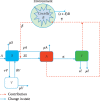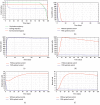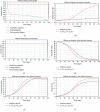A Deterministic Model for Q Fever Transmission Dynamics within Dairy Cattle Herds: Using Sensitivity Analysis and Optimal Controls
- PMID: 32089730
- PMCID: PMC7013282
- DOI: 10.1155/2020/6820608
A Deterministic Model for Q Fever Transmission Dynamics within Dairy Cattle Herds: Using Sensitivity Analysis and Optimal Controls
Abstract
This paper presents a differential equation model which describes a possible transmission route for Q fever dynamics in cattle herds. The model seeks to ascertain epidemiological and theoretical inferences in understanding how to avert an outbreak of Q fever in dairy cattle herds (livestock). To prove the stability of the model's equilibria, we use a matrix-theoretic method and a Lyapunov function which establishes the local and global asymptotic behaviour of the model. We introduce time-dependent vaccination, environmental hygiene, and culling and then solve for optimal strategies. The optimal control strategies are necessary management practices that may increase animal health in a Coxiella burnetii-induced environment and may also reduce the transmission of the disease from livestock into the human population. The sensitivity analysis presents the relative importance of the various generic parameters in the model. We hope that the description of the results and the optimality trajectories provides some guidelines for animal owners and veterinary officers on how to effectively minimize the bacteria and control cost before/during an outbreak.
Copyright © 2020 Joshua Kiddy K. Asamoah et al.
Conflict of interest statement
The authors declare that they have no conflicts of interest.
Figures






Similar articles
-
Analysis of Q fever in Dutch dairy goat herds and assessment of control measures by means of a transmission model.Prev Vet Med. 2016 Jan 1;123:71-89. doi: 10.1016/j.prevetmed.2015.11.004. Epub 2015 Nov 18. Prev Vet Med. 2016. PMID: 26708798
-
Coxiella burnetii (Q fever) in Rattus norvegicus and Rattus rattus at livestock farms and urban locations in the Netherlands; could Rattus spp. represent reservoirs for (re)introduction?Prev Vet Med. 2011 Aug 1;101(1-2):124-30. doi: 10.1016/j.prevetmed.2011.05.003. Epub 2011 Jun 2. Prev Vet Med. 2011. PMID: 21640416
-
High seroprevalence of Coxiella burnetii in dairy cattle in China.Trop Anim Health Prod. 2016 Feb;48(2):423-6. doi: 10.1007/s11250-015-0968-3. Epub 2015 Dec 15. Trop Anim Health Prod. 2016. PMID: 26669596
-
[Coxiella burnetii: what is the reality?].Parassitologia. 2004 Jun;46(1-2):131-4. Parassitologia. 2004. PMID: 15305702 Review. Italian.
-
Clinical microbiology of Coxiella burnetii and relevant aspects for the diagnosis and control of the zoonotic disease Q fever.Vet Q. 2013;33(3):148-60. doi: 10.1080/01652176.2013.843809. Epub 2013 Oct 28. Vet Q. 2013. PMID: 24161079 Review.
Cited by
-
Sensitivity assessment and optimal economic evaluation of a new COVID-19 compartmental epidemic model with control interventions.Chaos Solitons Fractals. 2021 May;146:110885. doi: 10.1016/j.chaos.2021.110885. Epub 2021 Mar 20. Chaos Solitons Fractals. 2021. PMID: 33776250 Free PMC article.
-
Optimal control analysis of Taenia saginata bovine cysticercosis and human taeniasis.Parasite Epidemiol Control. 2021 Dec 31;16:e00236. doi: 10.1016/j.parepi.2021.e00236. eCollection 2022 Feb. Parasite Epidemiol Control. 2021. PMID: 35028439 Free PMC article.
-
Evaluation of the Diagnostic Potential of Recombinant Coxiella burnetii Com1 in an ELISA for the Diagnosis of Q Fever in Sheep, Goats and Cattle.Microorganisms. 2020 Aug 13;8(8):1235. doi: 10.3390/microorganisms8081235. Microorganisms. 2020. PMID: 32823774 Free PMC article.
-
A Review on Important Zoonotic Bacterial Tick-Borne Diseases in the Eastern Mediterranean Region.J Arthropod Borne Dis. 2021 Sep 30;15(3):265-277. doi: 10.18502/jad.v15i3.9814. eCollection 2021 Sep. J Arthropod Borne Dis. 2021. PMID: 36578998 Free PMC article. Review.
-
Caputo SIR model for COVID-19 under optimized fractional order.Adv Differ Equ. 2021;2021(1):185. doi: 10.1186/s13662-021-03345-5. Epub 2021 Mar 24. Adv Differ Equ. 2021. PMID: 33777127 Free PMC article.
References
-
- CDC. Centers for Disease Control: Q Fever Transmission. Atlanta, GA, USA: CDC; 2019. https://www.cdc.gov/qfever/transmission/index.html.
-
- Ostfeld R. S. Zoonoses: Infectious Diseases Transmissible between Animals and Humans. Chicago, IL, USA: University of Chicago Press; 2017.
-
- OIE. World Organisation for Animal Health. Paris, France: OIE; 2019. http://www.oie.int/en/animal-health-in-the-world/animal-diseases/Q-Fever/
-
- Dirct H. Free Australian health advice you can count on: Q fever. 2019. https://www.healthdirect.gov.au/q-fever.
-
- Schimmer B. Dutch Q Fever Epidemic in a ‘One Health’ Context: Outbreaks, Seroprevalence and Occupational Risks. Utrecht, Netherlands: Utrecht University; 2018.
MeSH terms
LinkOut - more resources
Full Text Sources

